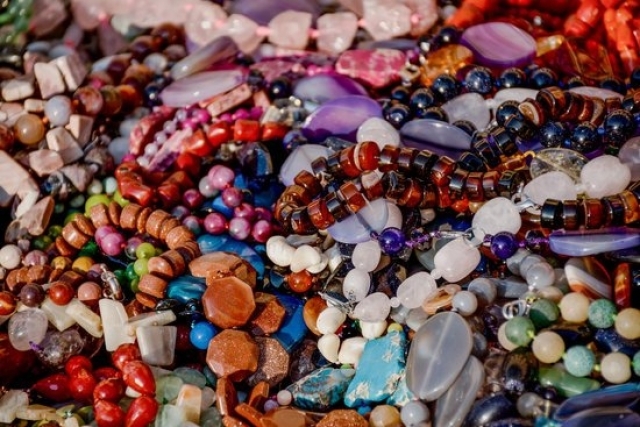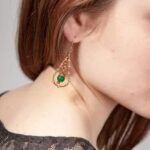The 1930s were known as the Art Deco jewelry years and this distinct style of jewelry is still in demand today. During this period, three distinct trends emerged; the influence of French designs, the combination of modern materials with traditional craftsmanship, and the use of crystals as decorations. All of these design elements are seen in many of the popular pieces from this era.
The most prevalent style during this decade was French influence. Many pieces from this time were inspired by the intricate designs French jewelers were making at that time. These pieces featured detailed combinations of diamonds and other precious gems set into gold or white gold mounted settings. Styles like chokers, earrings, necklaces, and pendants often showcased bold colors such as blue sapphires or emeralds with smaller accent stones mixed in to create interesting multi-level effects.
Modern materials used during Art Deco Jewelry Years were also popular. Jewelers often combined metal components with complicated engravings in order to give their pieces a unique look. This was done by using lighter metals such as aluminum, steel, and stainless steel alongside gold or silver for contrast and texture in items like bangles, brooches, hair clips, cuffs and headbands.
Crystals were a major part of Art Deco styled jewelry created during these years too as they added sparkle and glam to accessories such as chandelier earrings or elaborate necklaces featuring crystal drops made from diamonds or colored stones like rubies or emeralds. The addition of crystals enabled jewelers to create sensational looking necklaces with spectacular focal points which became highly sought after pieces within society circles at that time.
Overall Art Deco jewelry is still highly prized for its beauty and timeless nature today which is why so many people look back on it fondly when considering their vintage collections or special occasion gifts. It will remain a classic style that can be appreciated by both young girls dreaming about princesses wearing sparkling tiaras as much as more mature ladies who appreciate exquisite quality pieces that stand out from the crowd every time they wear them proudly.
Evolution of Art Deco Jewelry Through the Decades
The Art Deco era was a fashionable movement that spread across the Western world from the 1920s until the mid-1930s. The jewelry from this period is known for its bold, geometric lines combined with intricate designs and luxurious materials. While the original styling of art deco jewelry is often referred to as vintage or antique, there have been numerous modern interpretations over more recent decades.
1920s
The birth of Art Deco style jewelry was in the 1920s when it was popular among many high society circles, first becoming especially influential during the Exposition internationale des arts décoratifs et industriels modernes in Paris in 1925. This decade saw the use of platinum being introduced into jewelry designs due to its malleable nature and ability to hold fine details.
Gold was less sought after due to increasing restrictions on ownership that had been put in place as a result of World War I. However, this didn’t stop lovers of fine jewelry, and diamonds remained a central feature in many pieces with intricate settings using trademark Art Deco craftsmanship and materials such as jade, rock crystal, onyx, enamel and platinum.
1930s
By the 1930s Art Deco had become increasingly popular throughout Europe and North America resulting in more affordable, mass-produced pieces being made available for wider consumption by those who were not limited by budget restrictions. Pieces began featuring colored gemstones alongside highly stylized metalwork inspired by biological forms (e.g., leaves and flowers) or abstract designs like overlapping bars which symbolize energy or speed.
The distinctive vertical lines found in many art deco pieces also featured heavily during this decade representing ambition and striving towards greatness which fitted with growing ambitions during this period; particularly post Great Depression when people were desperate for success and wealth once again.
1970s
Although art deco design primarily dates back to the years between WWI and WWII (around 1919-1935), much of its influence on modern jewelry can be seen today.
During this time there was renewed interest in what was now considered’vintage’ style but with adaptions to suit modern tastes; e.g undervalued gemstones such as mandarin garnet became highly sought after due to their affordability compared to diamonds but still offered similarly striking colour variations when used in handcrafted necklaces or earrings designed with mixed metals/tones.
Similarly other adaptions such filigree work was common adding additional detail through lace-like detailing without sacrificing ‘the’ sophisticated feel associated with art deco styles; moreover replicas of some of Gatsby’s iconic movie pieces sparked an entire line of new products around this period further driving marketing for contemporary brands.
Art Deco
The Art Deco jewelry years from roughly 1910 to 1940 was a distinct and coveted period in jewelry history. In this era, adventurous folks were enjoying bolder, more daring styles than ever before. This was an age where glamorous geometric shapes such as reflective sunbursts or sleek, linear chevrons offered vibrancy to accessories. Jewelers were unapologetic in their indulgence of semi-precious and precious metals, like gold, platinum and silver; precious stones; and even avant-garde materials like bakelite plastics.
Art Deco motifs played with various interpretations of the word “style” – ranging from modestly elegant necklaces created using angular lines coupled with symmetrical gems to intricate scaled-down figures made from vibrant ivory or tortoiseshell inserts. These trinkets spoke volumes without having to be loud, drawing attention from those travelling through metropolitan cities thanks to its geometric shapes or colorful enamels emblazoned with iconic 20th century symbols.
The most commonly viewed Art Deco symbols included birds and mythological creatures (particularly the sphinx), figured heads, pyramids, geometric zigzags, and chevron patterns which could all be found in both large pieces of jewellery like brooches and smaller objects such as pendants and earrings. Furthermore, decorative cabochon-style gemstones like lapis lazuli or malachite stones offered darker hues when needed for contrast against the backdrop of other-worldly themed figures such as gods/goddesses silhouettes found on rings and bracelets.
The bygone era embraced luxury at an exciting level which allowed creative visionaries luxuriate in any manner they saw fit with their craftsmanship skills being tested at nearly every corner.
Popular Pieces of Art Deco Jewelry
The Art Deco period of the 1920s was an iconic era when it came to fashion. During this decade, jewelry played a major role in expressing a person’s individual style and it still holds the same meaning today. Art Deco jewelry often features geometric shapes comprised of diamonds, colored stones and placed onto gold and platinum.
The most popular pieces were made from European stones which were known for their unique cut patterns and two-tone colors. Not only were diamonds used during this period but so were materials like jade, semi-precious stones, glass beads and turquoise which resulted in statement pendants, tasselled earrings and unusual hand crafted necklaces act as timeless classics.
Brooches
Brooches were one of the most extravagantly decorated pieces worn during this time and their popularity lasted throughout the twenties. The variety structure in terms of size meant they could be worn as formal accessories or used casually with daywear attire.
Classic vivid designs featured gemstones cut into different shapes such as rectangles, Stars and crosses grouped together with other details like animal figures or circular elements to brighten up an otherwise plain outfit. Long chain tassels combined with over sized gemstones are typical features associated with these embellishments.
Rings
This striking trend is often represented by a single bold diamond set against yellow or white metal to create an eye catching piece of jewelry used mainly on special occasions such as parties or weddings.
This type detailed craftsmanship required expert jewelers who worked tirelessly carving intricate designs from rubies sapphires and emeralds to add a luxurious feel to any desired piece_ Rings featuring multiple geometrical shaped gemstones especially if they had marquise or pear shape stones are highly valued as collectables due to its enduring popularity throughout the twenties era.
Bangles
These thin sleek bangles can add a fashionable twist to any outfit regardless if you’re looking for a classic approach or a more contemporary look. Highly sought after by many designers today due to its versatility, Art Deco bangles come in various styles ranging from wide polished bands with gold accents these carried abstract shapes covered in multi colored gemstones adding brightness around your wrist.
Famous Art Deco Jewelry and Designers
Art Deco Jewelry first appeared in the 1920s and 1930s, during the late Art Nouveau period. This type of jewelry is characterized by its geometric shapes and use of modern materials such as plastics, gemstones, and metal alloys. It is often seen as being flashy and over-the-top with jewelled motifs, abstract forms, planes of contrast, and strong color combinations. The combination of metallic colors further add to this aesthetic for a bold look.
Many famous designers made their mark in this era of jewelry craftsmanship and design. Jean Després was responsible for creating the curvilinear jewelry that reflected the geometric architectural designs that were popular at this time.
Suzanne Belperron is also recognized as one of most iconic figures of this era who constantly pushed the boundaries in terms of creative expressionism through her jewelry designs. Other leading figures include Fouquet and Countess de Rachewilz who used precious metals to create vivid pieces with an attention to detail that was ahead of their time.
Notable Highlights from Art Deco Jewellery Designs
- The use of triangular shapes for cutouts
- Wide use of silver combined with gold or crystal
- Mixing materials such as rock chrystals or colorful gems
- Inspiration derived directly from nature, including hand-crafted flowers
- Expertly crafted enamels on rings and necklaces
- Pieces featuring intricate filigree decoration
How to Spot Authentic Art Deco Jewelry
Art Deco jewelry became popular between the 1920s to the 1940s due to its unique geometric shapes and loud colors. The bold design of this style of jewelry often makes it instantly recognizable within a collection. While modern renditions make it hard to discern period appropriate pieces from recent creations, there are several ways in which authentic Art Deco jewelry can be identified.
Design Characteristics
The most iconic feature of Art Deco jewelry is its geometric and abstract designs. During this period, rings and earrings were primarily crafted on a rectangular or square basis, while necklaces and bracelets typically featured overlapping circles or curves with diamond accents. Additionally, colorful precious stones like rubies, opals, sapphires, turquoise and tourmalines were generally used for earrings, brooches and bracelets in a variety of cuts including baguette, emerald and marquise.
Manufacturing Details
Authentic Art Deco jewelry will come with detailed instructions on the period when it was created as well as where the piece was manufactured – often Europe or America (specifically France).
Furthermore, since this type of jewelry was commonly made out of, sterling silver, 14-18 karat gold or platinum during that era; a clear indication should be given for any original piece purchased in 2020 or later that states what metals were used in order to authenticate the item’s origin.
Symbols & Signatures
Art Deco styles are usually marked by makers on the backside piece. This could include symbols like an eagle for French-made or a ‘925’ marking that indicates sterling silver material. Designs may have even been signed by particular jewelers – famous American makers like Giganti & Co employed their own signature hallmark while other European manufacturers like Jean Despres also had similar identifiers stamped with pieces they produced during that time frame for authenticity’s sake.
Cleaning and Storing Your Art Deco Jewelry
Art Deco jewelry has become increasingly popular over the years due to its variety of distinct designs. Dating all the way back to the 1920s, Art Deco jewelry can be found in a range of styles such as bold geometric shapes, abstract designs, and bright colors.
Anyone lucky enough to own a piece of Art Deco jewelry knows that it has a timeless elegance and value that cannot be replicated. In order to keep your Art Deco jewelry looking its best, it is essential to properly clean and store it on a regular basis.
The first step in properly cleaning your Art Deco jewelry is to identify what type of metal it is made out of. Different types of metals require different types of cleaners for optimal results so this part should never be overlooked or underestimated. Once you have determined the correct cleaner, you can begin by lightly dampening a soft cloth with warm water and adding a few drops from the cleaner bottle onto the cloth.
Gently rub down the entire piece of jewelry until any dirt or residue is removed before rinsing thoroughly with fresh spring water and drying off with an additional soft cloth afterwards. Be sure not to use any harsh or abrasive substances as these may damage and scratch the metal surface permanently.
When storing your Art Deco Jewelry, you want to ensure they are kept safe from dust and away from moisture in order for them to last as long as possible without tarnishing or fading in color over time. One way to guarantee maximum protection for your jewelry pieces is through keeping them wrapped individually in protective bags so they remain dust-free at all times.
Additionally, storing them inside airtight containers will prevent any moisture getting inside which could potentially damage them in ways such as causing oxidation or allowing bacteria growth over time.
It’s also important not to leave them exposed on counters or open shelves for extended periods of time since this could potentially attract thieves hoping for an easy score. If you would like extra protection against theft, consider installing hidden drawers or safes in which all valuable items can safely be locked away when not being used.
By taking these necessary steps often into cleaning and storing your valuable art deco jewelry pieces accordingly, you can be sure that each item will withstand environmental factors while still providing many years worth of classic beauty and appeal.
Final Thoughts on Art Deco Jewelry
The Art Deco Jewelry years, which began around the 1920s and continues today, have produced some of the most beautiful pieces of jewelry ever seen. The art deco style is characterized by its geometric shapes and bright colors, and was popular during the time due to its sleekness. From intricate diamond tassels to multi-colored crystal earrings, the Art Deco period served as a source of inspiration for many jewelers.
The hallmark of any Art Deco piece is the use of angular shapes combined with bright colors, like vibrant blues and pinks. Gold, platinum and other precious metals were often used in combination with colored stones such as turquoise and coral to create colorful pieces.
Bold, geometric designs were also a mainstay of this era’s jewelry designs. Whether the jewelry was ornate or minimalistic in design, it tended to draw attention from onlookers while still being delicate enough for everyday wear.
The demand for fashionable yet affordable jewelry meant that production methods became more efficient during these years. This allowed jewelers to use various techniques that could be employed in mass production as well as upper class high-end examples made from rare materials such as platinum and diamonds.
Many different styles were created during this time ranging from bold statement jewelry with large gemstones making up floral designs, to small diamond encrusted pieces meant only for an elite few who could afford them.
No matter what type of jewelry you prefer and admire there’s no doubt that jewelry from the Art Deco Period has influenced modern culture’s tastes since then till today. As they still hold fascination on modern day wearer’s fashion choices while maintaining their iconic look through remakes from both vintage originals or reinventions by contemporary designers inspired by them alike.
As a craftsmanship this category stands out particularly with their exotic look achieved through their abstract geometric patterns mixed even further with abundant shine coming out their usually expensive metals or mix of eclectic materials often found at craft markets near you today.

Welcome to my jewelry blog! My name is Sarah and I am the owner of this blog.
I love making jewelry and sharing my creations with others.
So whether you’re someone who loves wearing jewelry yourself or simply enjoys learning about it, be sure to check out my blog for insightful posts on everything related to this exciting topic!





